I’m of an age when I fear that each trip I make to my former home, Vienna, may be my last opportunity to stroll the streets where Mozart walked, to hear his operas in the theater where the world’s most acclaimed singers perform, and to visit the museum where some of civilization’s greatest paintings hang. And so it was this past March. An unexpected business trip to Austria and Italy required meetings in Vienna supplemented by two days in the southern state of Carinthia before heading back to Vienna and then on to Italy. Boarding the Vienna-bound Austrian Airlines flight at Charles de Gaulle Airport outside Paris, I felt almost home as the flight attendant offered me a glass of Grüner Veltliner, Austria’s renowned white wine, and I was enveloped by animated conversations in "Austrian" German.
I was fortunate to land on a frigid but sunny afternoon affording a chance to stave off jet lag with a walk around the First District, the historical and archeological center of the city dating back to Roman times. Staying at the Schlosshotel Römischer Kaiser on the Annagasse was ideal. A tiny boutique hotel in a Baroque former palace, it stands around the corner from a concert hall at the Academy of Music and Dramatic Arts where I first sang in this music capital of the world – the audition upon which my entire future depended (or so it seemed at the time).
While Vienna is a modern capital, full of business enterprise, it remains a major tourist destination. Even on a chilly Wednesday afternoon in late winter, Kärtnerstrasse was full of tourist groups headed down the pedestrian zone to the magnificent Gothic Cathedral of Saint Stephen and then along the Graben toward another cathedral of sorts, Demel’s, world-renowned for its Sachertorte and for serving hundreds of worshipful pastry lovers each day.
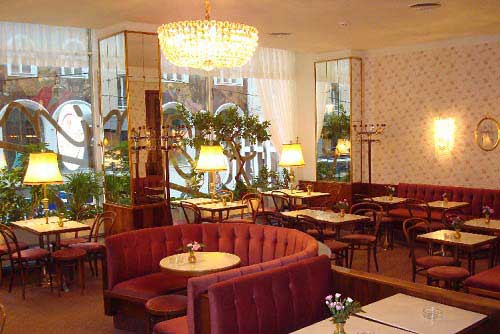
For me, however, the ultimate destination was Heiner’s, the tiny café, pastry, and chocolate emporium that has been a treasured haunt for over 30 years. How comforting, I reflected, that nothing other than prices ever changes — not the décor, not the china service, not the silverware — except that I am now as old as the elegantly dressed patrons I had once thought so aged. I ordered my “usual,” a Kremschnitt made of layers of puff pastry filled with whipped cream and topped with strawberry icing, accompanied by a Mélange, a dose of Vienna’s strong coffee with just a bit of steamed milk. Suitably fortified, I headed off for meetings with my colleagues, Georg Stöger and Ulrich Paugger, at UHY Vienna.
Afterward, I enjoyed a relaxing evening at Bio Restaurant Weinbotschaft (literally, Wine Embassy), the all-natural eatery a few steps from my hotel and which I had spied on my earlier walk. While I don’t go out of my way to find organic foods or wines, I was delighted with the results. I enjoyed a fish (whose complicated name I have forgotten) that was caught in local waters and accompanied by steamed vegetables whose foamy treatment reminded me of WD-50 in New York. Rounding off the meal were two glasses of a richly hued and complex Blaufränkisch wine, redolent of cherries and forest berries, made from a variety of late ripening grapes grown in Austria since medieval times. This vintage could be a peerless ambassador for Austrian wines, or any organic red wines for that matter.
The next day found me on a train to Klagenfurt, snaking through mountains past picturesque villages to the southern end of the country near the border with Slovenia and a few kilometers from Italy. I had sung Haydn’s oratorio, The Creation, decades ago in Klagenfurt but when I arrived this time, absolutely nothing looked familiar. My taxi driver, a native of the city, spent the trip from train station to hotel pointing out pizzerias and trattorias while complaining that no one wanted to eat traditional Carinthian food anymore. Fortunately, that was in store for me a few hours later at Bierhaus zum Augustin, a classic beer joint serving delicious but huge helpings of local fare to the locals who still crave it. I found Gösser Bier on tap, and enjoyed a Seidl (one-third liter) of their dark brew that is deeply flavorful and satisfying, like drinking a loaf of bread. The pork medallions I ordered were moist and delicious, accompanied by potato croquettes, Carinthia’s answer to the French fry but superior at soaking up gravy.
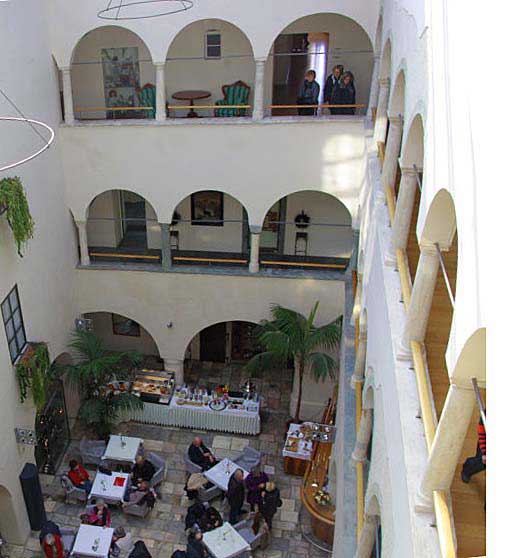
My hotel in Klagenfurt turned out to be an architectural gem. Das Salzamt Palais Hotel Landhaushof (Salt Office Palace Hotel at the State House Courtyard) occupies a Renaissance era edifice that once housed the government salt exchange. The building has three stories of arcaded walkways ringed by former offices converted into hotel rooms. The atrium, now covered by a roof with glass skylight, is beautiful and evokes a time when the Salt Office was a beehive of activity facilitating the purchase and sale of salt for the entire region. Unfortunately, the décor in the atrium (also the breakfast room) was jarringly contemporary, and the reception area so run down I was convinced the taxi driver had dropped me at the wrong spot. As I struggled to help the receptionist locate my reservation and then the correct price of the room I had booked, I was reminded of the quaint expression the Austrians use in the face of Kafkaesque bureaucratic dysfunction, man kann sich beim Salzamt beschweren, or "go complain to the Salt Office." Here I was, living that futility at its source. When I finally made it to my room, it proved large and recently re-decorated with a sweeping view of the main square below. Too bad I would only be staying one night.
The next day, I set out toward Villach through mountain valleys and along the Wörther Lake to an industrial park for a meeting with my client. Ringed by tall mountains, this region of Austria is an industrial powerhouse where smokestacks dot the landscape, disproving tourists’ preconceptions about the country being one giant ski resort.
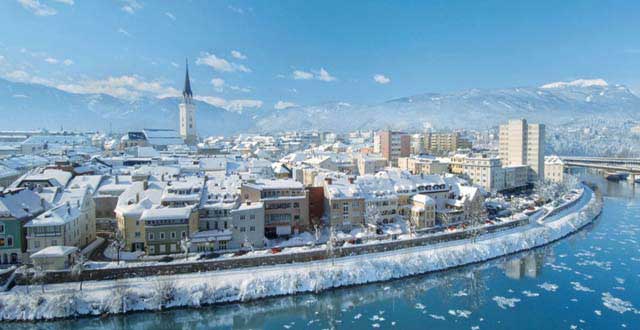
The sunshine was brilliant but winter had not yet loosened its snowy grip as I found when I wandered through the pedestrian zone in Villach, rolling suitcase in tow, looking for a spot to eat lunch before catching the train back to Vienna. The day’s menu posted outside the Goldenes Lamm offered an irresistible dish — pan seared duck breast. It was perfectly cooked, the meat slightly pink and served with a burgundy wine sauce on a bed of fragrantly spiced red cabbage, all accompanied by a glass of Blauer Zweigelt (a modern hybrid of Blaufränkisch and Saint Laurent grapes). My starter was a salad of grated potato and celery root, an ingredient I adore but rarely encounter. A post prandial walk up the hill and around the ancient parish church did me a world of good. As I headed back to the train station and the ride to Vienna, I stopped on the bridge across the Drava River to marvel at the beauty of the city and surrounding mountains bathed in winter sunshine.
The next day, Vienna afforded the experience I had dreamed of — a visit to the Kunsthistorisches (Art History) Museum. Posters and billboards around the city heralded the recent grand re-opening of the Kunstkammer, the gallery housing the treasures of the Habsburgs and showcasing Benvenuto Cellini’s magnificent salt cellar (known as the Saliera). Swiped from its display case in 2003 (valued at US$58 million) and recovered a few years later thanks to a text message and video surveillance from a cell phone store, this triumph of the goldsmith’s art has been restored to its rightful place. It was King Francis I of France who, in the mid-1600s, commissioned the elaborate vessel to hold what was then a very expensive and precious commodity reserved for the communal use of royal diners — salt.
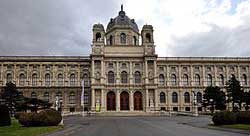
Considering the Habsburgs’ ownership of salt mines and their monopoly on the sale of salt, it seems fitting that Francis’ descendant, King Charles IX, bestowed the salt cellar on Archduke Ferdinand II, making it possible for the Habsburg nobility to pluck some of its revenue-generator from the world’s most magnificent and expensive salt shaker. Another gift from that king is also in the museum. “The Unity of the State” is a grand tapestry created for Fontainebleau Palace and showing Francis I decked out in Roman-looking ceremonial garb while wearing a pair of curious booties with lions’ faces on the front.
Since my last visit, the gallery has been completely redone and, most importantly, the ambience is breathtaking with spotlights on each object affording the opportunity for detailed study of treasures including diminutive ivory carvings based on mythological themes, jewel-encrusted drinking cups, silver-gilt automatons, and oodles of cameos.
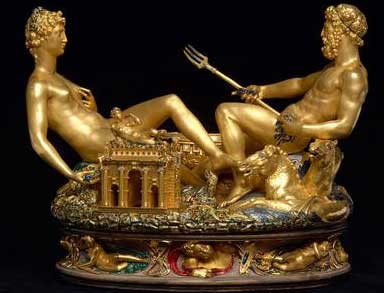
Cellini’s Salt Cellar was even more exquisite than I remembered. Made of gold and other precious elements, it depicts the sea god Neptune next to a tiny bowl where the salt would be placed — metaphorically the bounty from the sea (rather than Austria’s salt mines) as harvested along Italy’s Mediterranean coastline. Paired with him is the goddess Tellus next to a receptacle for peppercorns — the bounty from the earth. The two figures recline away from one another, as if in a backyard spa. Approximately 11 inches by 11 inches, but presumably too heavy for diners to lift considering all the gold involved, the salt cellar rests on invisible ivory balls permitting it to be rolled back and forth on a table. Oh to be at a grand banquet where the Emperor sends the salt cellar careening in one’s direction.
After wandering the Kunstkammer, I headed to the museum’s wonderful café situated among the columns at the top of the grand staircase. I sat down across from another masterpiece, the case of magnificent pastries from which I chose a slice of scrumptious Maximiliantorte (layers of almond cake alternating with chocolate/nougat pastry cream named for the Habsburg Emperor) preceded by a light and delicious sandwich of smoked salmon and arugula on brioche. Restored and ready for more great art, I spent the balance of the afternoon in the collection of Old Master paintings, reunited with the “friends” I had known intimately when free admission with my student i.d., coupled with luxurious central heating, made the museum a refuge on many a frigid winter afternoon during my student days living on nearby Burggasse.
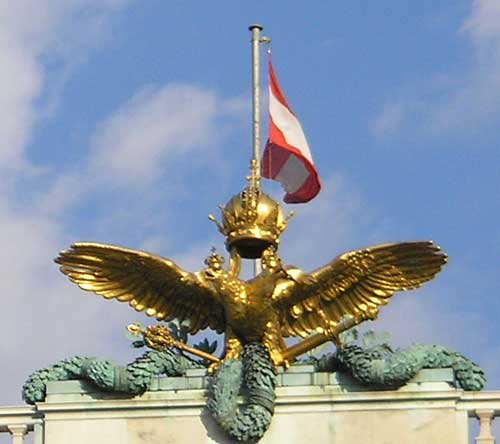
The late afternoon sunshine beckoned me outdoors, as it did so many inhabitants of the city on one of those rare days when the gray gloom of wintertime lifts and everyone heads outside to enjoy the respite. I strolled through the Hofburg Palace complex on my way back to the hotel, recalling the ball I attended there and where I waltzed until dawn to the soaring melodies of Johann Strauss the Younger. A feast for the eyes, the huge double-headed eagle gleamed in the sunlight atop the Neue Burg, with the Austrian flag waving in the breeze.
That evening, my last in Vienna on this trip, was spent with friends Eva and Wolfgang Holzmair. Eva is a translator and writer of fiction. Wolfgang and I were classmates at the Music Academy, students of the legendary Hilde Rössel-Majdan. In addition to being an opera singer and teaching at Salzburg’s Mozarteum, Wolfgang is the consummate Lieder interpreter of our generation with dozens of CDs to his credit. His groundbreaking recording of Ernst Krenek’s Reisebuch aus den osterreichischen Alpen or Travelogue of the Austrian Alps evokes darker and more forbidding mountains than those I had admired the previous day in Villach. Had we taken our cue from a song on that CD, Unser Wein or Our Wine, we could have sympathized with Krenek’s lament about Austrian wines being valued only by those who seek them out. For us to enjoy, Wolfgang had sought out a rare bottle of sparkling wine, a Riesling Brut, from the Szigeti winery in the Burgenland region near Hungary. We toasted Michael, my husband and usual travel partner, who was absent from this trip.
For dinner, we headed to Strandhaus, a fish restaurant in the Naschmarkt, Vienna’s traditional open-air food market and now a mecca for fine eateries as well. There we feasted on mussels and on grilled fish accompanied by a Grüner Veltliner from the nearby Kremstal region where vineyards cover the hillsides encircling medieval villages nestled along the Danube River. It was a delightful evening of conversation with old friends, the intervening years melting away as we chatted about music and recalled our student days. Our final stop that evening was Wein & Co for the Holzmairs to send home with me a favorite red wine (Gager’s Quattro) and chocolate (artisanal, from Zotter in Riegersburg) for Michael and me to enjoy.
The next morning I awoke to snow. As I sat by the window in the hotel’s breakfast room, enjoying the strong coffee and freshly baked croissants (both originally appropriated from Turks as they retreated from outside the city’s gates after a failed invasion back in the 17th century), memories came rushing back. Viennese winters had always seemed endless to me and the prospect of spring desired so desperately. I watched the snowflakes as they meandered earthward and then melted on the street amidst a dampness that chills to the bone. Unable to bolster the momentum for a real snowstorm they furnished an extra layer of misery for anyone trudging about.
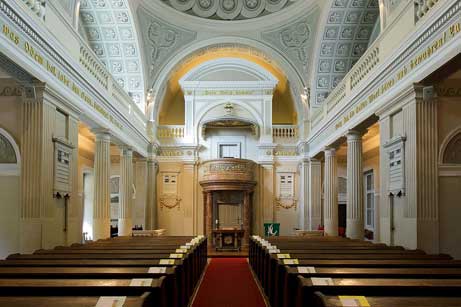
With my bags already packed for heading to the airport that afternoon, I had just enough time to attend a Sunday morning service at the Vienna Community Church where I used to sing in the choir. The Baroque-era Reformierte Stadtkirche is one of the few Protestant churches, dating back to the Reformation, in this Catholic city. As I sat in the stiff wooden pew and admired anew the elaborate interior, I wondered if Mozart, who had performed in that same upstairs choir loft in close proximity to the “coffered” ceiling, had discovered its secret. What appeared to be intricate carving of recessed squares filled with rosettes, was in fact a triumph of trompe l’oeil painting on a curved surface and much less expensive than the real thing. I was startled from my reverie by Louise and Anne, two fellow choristers from decades ago who remembered me and still attend this warm and welcoming sanctuary for English-speakers far from home.
As I bade them farewell and stepped out onto the Dorotheergasse I felt a crunch under my boot. Looking down, I saw that the icy sidewalk had been generously spread with rock salt. I chuckled at how this almost priceless substance, on which an empire had been built, was now just a throw-away item.
Schlosshotel Römischer Kaiser, Annagasse 16, A-1010 Wien
L. Heiner Hofzuckerbäcker, Kärtnerstrasse 21-23, A-1010 Wien
Kunsthistorisches Museum Wien, Maria-Theresien-Platz, A-1010 Wien
Wolfgang Holzmair, Baritone
Eva Holzmair’s novel, Mir träumte, du lägest im Grab.: Mord in der Grand Opéra, is available from on-line booksellers.
Next time, a brief visit to Bologna where a little dove re-invents classic dishes.
The original version of this article appeared in the Summer, 2013 edition of the Quarterly Newsletter of the Wine Society of Texas, a non-profit organization dedicated to wine education and appreciation.